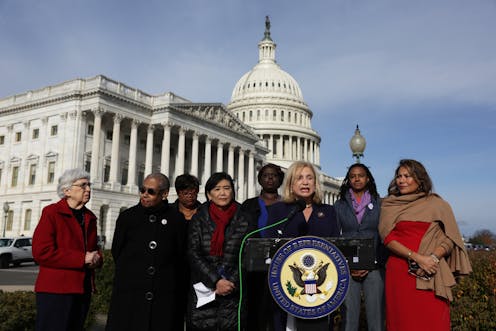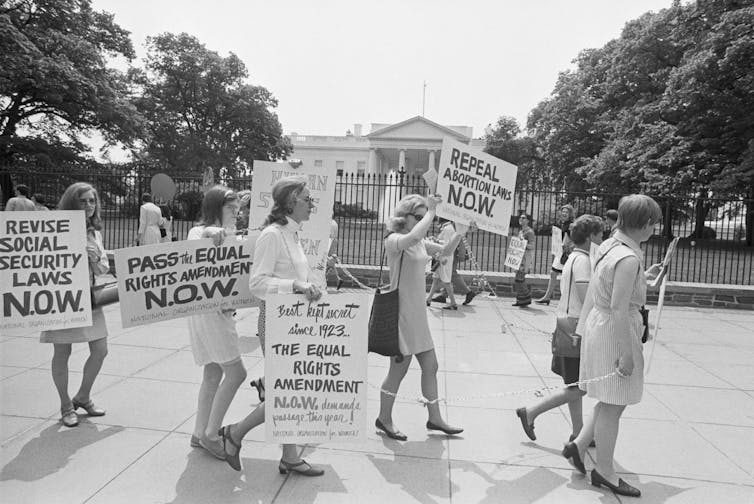
Democrats in Congress are making a new push to get the long-dormant proposed Equal Rights Amendment enshrined into law. As legislation, it would guarantee sex equality in the Constitution and could serve as a potential legal antidote to the Supreme Court’s 2022 decision in Dobbs v. Jackson Women’s Health Organization, which removed the federal right to an abortion.
“In light of Dobbs, we’re seeing vast discrimination across the country,” said U.S. Sen. Kirsten Gillibrand of New York in an interview July 13, 2023. “Women are being treated as second-class citizens. This is more timely than ever.”
Gillibrand, U.S. Rep. Cori Bush of Missouri and other Democratic lawmakers are arguing that the Equal Rights Amendment, often referred to as the ERA, has already been ratified by the states and is enforceable as the 28th Amendment to the Constitution.
Efforts to amend the U.S. Constitution to recognize women’s rights have faced major challenges for the past century. Most recently, in April 2023 Senate Republicans blocked a similar resolution that would let states ratify the amendment, despite an expired deadline.
I’m a scholar who studies gender and politics. Here’s a quick summary of how the country got to this point and the barriers that still exist to adding the Equal Rights Amendment to the Constitution.

‘Ladies against women’
Women’s rights advocates argue that sex discrimination is a pervasive problem that could be resolved by the ERA. Even though the Equal Protection Clause in the 14th Amendment prohibits states from denying any person equal protection under the law, women’s rights are not explicitly guaranteed.
In the wake of the Supreme Court’s Dobbs decision, which took away a woman’s right to an abortion, women’s rights advocates argue that the ERA is critical in the post-Dobbs world. The amendment could help protect women’s access to reproductive health services, including abortion and contraception.
Proponents also believe that the ERA can be used to push back against legislation that threatens the rights of LGBTQ+ people.
The push for equal rights first heated up in the 1920s after women gained the right to vote.
Alice Paul, a suffragist, proposed the first version of an Equal Rights Amendment in 1923. The language of the legislation, which is very similar to the amendment Democrats are currently championing, guaranteed equal rights under the law, regardless of a person’s sex.
The proposal was adopted and turned into proposed legislation by two Kansas Republicans, Sen. Charles Curtis and Rep. Daniel Anthony Jr., and was brought up during every congressional session between 1923 and 1971 without success.
The idea of an Equal Rights Amendment, however, gained momentum among politicians and the broader public. World War II opened many doors for women, who filled gaps in the labor force while men were off fighting. During this time, women were welcomed into politics, onto juries, openly wooed by educational institutions and encouraged to take up male-dominated majors such as math, science and technology.
The fledgling feminist group, the National Organization for Women, adopted the passage of the ERA in its 1967 Bill of Rights for Women and began staging massive demonstrations and lobbying politicians in the late 1960s and early 1970s in an effort to get Congress to pass the amendment.
Finally, in 1972, the ERA passed both houses of Congress. The amendment had seven years to be ratified by three-fourths, or 38, of the 50 states.
While 30 states ratified the ERA in 1972 and 1973, the amendment ultimately came up three states short of approval by the 1979 deadline.
This was in large part due to the efforts of conservative women’s organizations opposed it. Conservative women said that the ERA was a threat to family and child-rearing, because it would disrupt traditional gender roles. They also believed women would lose, among other things, their exemptions from the draft and combat duty.
At the same time, for a number of reasons, Nebraska, Tennessee, Idaho, South Dakota and Kentucky rescinded their ERA ratifications between 1972 and 1982. Some state legislators argued that the amendment was too controversial given its potential to upend traditional gender roles and legalize what they called “abortion on demand.”
States such as Illinois and Florida became battlegrounds for liberal and conservative women fighting over the amendment. Feminists successfully lobbied Congress to extend the ERA’s ratification deadline to June 30, 1982. The ERA, however, was not ratified by the three states needed to ensure its passage. In 1982, conservative women proclaimed the Equal Rights Amendment officially dead.
In 2023, conservative women’s groups like the Eagle Forum and Concerned Women for America continue to make the same arguments against the ERA. Instead of focusing on the battlefield, however, the groups argue that the ERA will eliminate restrictions on abortion and erase “women-only safe spaces” like bathrooms and locker rooms.

Another chance?
Since 2017, three more states – Nevada, Illinois and Virginia – have ratified the Equal Rights Amendment, bringing the total to 38 states, which is the number required to ratify the ERA and officially make it the 28th Amendment. That is why Democrats believe they have legal standing.
Some constitutional experts see Democrats’ latest attempt to codify the ERA as a political stunt rather than a legitimate legal move. To some extent, I think this may be true.
More than a dozen states have ERA equivalents that protect women’s equal rights in their constitutions. And four states, including New York, have active ERA initiatives.
The current push for Democrats to pass the ERA seems to be largely about advocating for abortion access and mobilizing abortion rights supporters ahead of the 2024 presidential election.
About half of the states across the U.S. have enacted restrictive abortion laws over the last year, with some states banning the procedure altogether. State ERA efforts, like the one in New York, are a response to these bans.
The renewed push for the ERA makes the fight over abortion access, once again, a national battle. In the current polarized political environment, abortion access promises to serve as a political lightening rod in coming years.
This is an updated version of an article originally published on Dec. 13, 2018.
Deana Rohlinger does not work for, consult, own shares in or receive funding from any company or organization that would benefit from this article, and has disclosed no relevant affiliations beyond their academic appointment.
This article was originally published on The Conversation. Read the original article.







